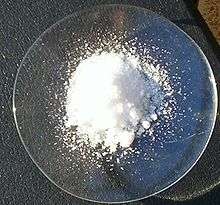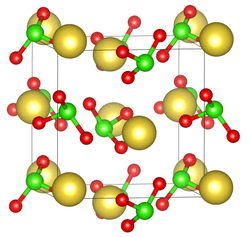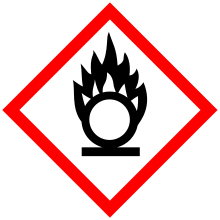Sodium chlorate
Sodium chlorate is an inorganic compound with the chemical formula NaClO3. It is a white crystalline powder that is readily soluble in water. It is hygroscopic. It decomposes above 300 °C to release oxygen[4] and leave sodium chloride. Several hundred million tons are produced annually, mainly for applications in bleaching pulp to produce high brightness paper.[7]
 | |
 | |
 Unit cell of sodium chlorate | |
| Names | |
|---|---|
| IUPAC name
Sodium chlorate | |
| Other names
Sodium chlorate(V) | |
| Identifiers | |
3D model (JSmol) |
|
| ChEBI | |
| ChemSpider | |
| ECHA InfoCard | 100.028.989 |
| EC Number |
|
| KEGG | |
| MeSH | Sodium+chlorate |
PubChem CID |
|
| RTECS number |
|
| UNII | |
| UN number | 1495, 2428 |
CompTox Dashboard (EPA) |
|
| |
| |
| Properties | |
| NaClO3 | |
| Molar mass | 106.44 g mol−1 |
| Appearance | Colorless or white solid, hygroscopic |
| Odor | Odorless |
| Density | 2.49 g/cm3 (15 °C)[1] 2.54 g/cm3 (20.2 °C)[2] |
| Melting point | 248–261 °C (478–502 °F; 521–534 K) |
| Boiling point | 300–400 °C (572–752 °F; 573–673 K) decomposes[1] |
| 79 g/100 mL (0 °C) 89 g/100 mL (10 °C) 105.7 g/100 mL (25 °C) 125 g/100 mL (40 °C) 220.4 g/100 mL (100 °C)[3] | |
| Solubility | Soluble in glycerol, hydrazine, methanol Slightly soluble in ethanol, ammonia[1] |
| Solubility in acetone | Sparingly soluble[1] |
| Solubility in glycerol | 20 g/100 g (15.5 °C)[1] |
| Solubility in ethanol | 14.7 g/100 g[1] |
| Vapor pressure | <0.35 mPa[2] |
| −34.7·10−6 cm3/mol | |
Refractive index (nD) |
1.515 (20 °C)[4] |
| Structure[5] | |
| cubic | |
| P213 | |
a = 6.57584 Å | |
Formula units (Z) |
4 |
| Thermochemistry | |
Heat capacity (C) |
104.6 J/mol·K[1] |
Std molar entropy (S |
129.7 J/mol·K[1] |
Std enthalpy of formation (ΔfH⦵298) |
-365.4 kJ/mol[1] |
Gibbs free energy (ΔfG˚) |
-275 kJ/mol[1] |
| Hazards | |
| Safety data sheet | ICSC 1117 |
| GHS pictograms |    |
| GHS Signal word | Danger |
GHS hazard statements |
H271, H302, H411[6] |
| P220, P273[6] | |
| NFPA 704 (fire diamond) | |
| Flash point | Non-flammable |
| Lethal dose or concentration (LD, LC): | |
LD50 (median dose) |
6500 mg/kg (rats, oral) 700 mg/kg (dogs, oral)[1] |
| Related compounds | |
Other anions |
Sodium chloride Sodium hypochlorite Sodium chlorite Sodium perchlorate Sodium bromate Sodium iodate |
Other cations |
Ammonium chlorate Potassium chlorate Barium chlorate |
Related compounds |
Chloric acid |
Except where otherwise noted, data are given for materials in their standard state (at 25 °C [77 °F], 100 kPa). | |
| Infobox references | |
Synthesis
Industrially, sodium chlorate is produced by the electrolysis of a hot sodium chloride solution:[7]
- NaCl + 3 H2O → NaClO3 + 3 H2
This reaction progresses in heat (at least 70 °C), and controlled pH. In lower temperature or with high pH another reaction progresses:
- 2 NaCl + H2O → NaClO + NaCl + H2
The sodium chlorate process is not to be confused with the Chloralkali process, which is an industrial process for the electrolytic production of sodium hydroxide and chlorine gas.
Uses
The main commercial use for sodium chlorate is for making chlorine dioxide (ClO2). The largest application of ClO2, which accounts for about 95% of the use of chlorate, is in bleaching of pulp. All perchlorate compounds are produced industrially by the oxidation of solutions of sodium chlorate by electrolysis.[7]
Herbicides
Sodium chlorate is used as a non-selective herbicide. It is considered phytotoxic to all green plant parts. It can also kill through root absorption.
Sodium chlorate may be used to control a variety of plants including morning glory, canada thistle, johnson grass, bamboo, Ragwort, and St John's wort. The herbicide is mainly used on non-crop land for spot treatment and for total vegetation control on areas including roadsides, fenceways, and ditches. Sodium chlorate is also used as a defoliant and desiccant for:
|
If used in combination with atrazine, it increases the persistence of the effect. If used in combination with 2,4-D, performance is improved. Sodium chlorate has a soil sterilant effect. Mixing with other herbicides in aqueous solution is possible to some extent, so long as they are not susceptible to oxidation.
The sale of sodium chlorate as a weedkiller was banned in the European Union in 2009 citing health dangers, with existing stocks to be used within the following year.[8]
Chemical oxygen generation
Chemical oxygen generators, such as those in commercial aircraft, provide emergency oxygen to passengers to protect them from drops in cabin pressure. Oxygen is generated by high-temperature decomposition of sodium chlorate:[9]
- 2 NaClO3 → 2 NaCl + 3 O2
Heat required to initiate this reaction is generated by oxidation of a small amount of iron powder mixed with the sodium chlorate, and the reaction consumes less oxygen than is produced. Barium peroxide (BaO2) is used to absorb the chlorine that is a minor product in the decomposition.[10] An ignitor charge is activated by pulling on the emergency mask. Similarly, the Solidox welding system used pellets of sodium chlorate mixed with combustible fibers to generate oxygen.
Oxygenless combustion
Sodium chlorate can be mixed with sucrose sugar to make a highly explosive fuel, similar to that of gunpowder, that burns in airtight spaces. This is the reaction:
8 NaClO3 + C12H22O11 → 8 NaCl + 12 CO2 + 11 H2O
However this sodium chlorate is mostly replaced by potassium chlorate.
Toxicity in humans
Sodium chlorate is toxic: "doses of a few grams of chlorate are lethal".[7] The oxidative effect on hemoglobin leads to methaemoglobin formation, which is followed by denaturation of the globin protein and a cross-linking of erythrocyte membrane proteins with resultant damage to the membrane enzymes. This leads to increased permeability of the membrane, and severe hemolysis. The denaturation of hemoglobin overwhelms the capacity of the G6PD metabolic pathway. In addition, this enzyme is directly denatured by chlorate.
Acute severe hemolysis results, with multi-organ failure, including DIC and kidney failure. In addition there is a direct toxicity to the proximal renal tubule.[11] The treatment will consist of exchange transfusion, peritoneal dialysis or hemodialysis.[12]
Formulations
Sodium chlorate comes in dust, spray and granule formulations. Mixtures of chlorates and organic compounds pose a severe risk of explosions[13]
Marketed formulations contain a fire retardant. Most commercially available chlorate weedkillers contain approximately 53% sodium chlorate with the balance being a fire depressant such as sodium metaborate or ammonium phosphates.
Trade names
Sodium chlorate is the active ingredient in a variety of commercial herbicides. Some trade names for products containing sodium chlorate include Atlacide, Defol, De-Fol-Ate, Drop-Leaf, Fall, Harvest-Aid, Kusatol, Leafex, and Tumbleaf. The compound may be used in combination with other herbicides such as atrazine, 2,4-D, bromacil, diuron, and sodium metaborate.
Sodium chlorate was an extensively used weed killer within the EU, until 2009 when it was withdrawn after a decision made under terms of EU Regulations. Its use as a herbicide outside the EU remains unaffected, as does its use in other non-herbicidal applications, such as in the production of chlorine dioxide biocides and for pulp and paper bleaching.
Cultural references
Historian James Watson of Massey University in New Zealand wrote a widely reported article, "The Significance of Mr. Richard Buckley's Exploding Trousers"[14][15] about accidents with sodium chlorate when used as a herbicide to control ragwort in the 1930s.[16] This later won him an Ig Nobel Prize in 2005,[17] and was the basis for the May 2006 "Exploding Pants" episode of MythBusters.
See also
References
- http://chemister.ru/Database/properties-en.php?dbid=1&id=786
- "GPS Safety Summary of Sodium Chlorate" (PDF). arkema.com. Arkema. Retrieved 2014-05-25.
- Seidell, Atherton; Linke, William F. (1952). Solubilities of Inorganic and Organic Compounds. Van Nostrand.
- CID 516902 from PubChem
- S. C. Abrahams, J. L. Bernstein (1977). "Remeasurement of Optically Active NaClO3 and NaBrO3". Acta Crystallographica. B33 (11): 3601–3604. doi:10.1107/S0567740877011637.
- Sigma-Aldrich Co., Sodium chlorate. Retrieved on 2014-05-25.
- Vogt, Helmut; Balej, Jan; Bennett, John E.; Wintzer, Peter; Sheikh, Saeed Akbar; Gallone, Patrizio (2000). "Chlorine Oxides and Chlorine Oxygen Acids". Ullmann's Encyclopedia of Industrial Chemistry. Weinheim: Wiley-VCH. doi:10.1002/14356007.a06_483.
- "Sodium chlorate banned by EC". Horticulture Week. 28 August 2008.
- Greenwood, Norman N.; Earnshaw, Alan (1997). Chemistry of the Elements (2nd ed.). Butterworth-Heinemann. ISBN 978-0-08-037941-8.
- Yunchang Zhang; Girish Kshirsagar & James C. Cannon (1993). "Functions of Barium Peroxide in Sodium Chlorate Chemical Oxygen". Ind. Eng. Chem. Res. 32 (5): 966–969. doi:10.1021/ie00017a028.
- Oliver J.; MacDowell M., Tracy A (1951). "The Pathogenesis of Acute Renal Failure Associated with Traumatic and Toxic Injury. Renal Ischemia, Nephrotoxic Damage and the Ischemuric Episode 1". J Clin Invest. 30 (12): 1307–439. doi:10.1172/JCI102550. PMC 441312. PMID 14897900.
- Goldfrank's Toxicologic Emergencies, McGraw-Hill Professional; 8th edition (March 28, 2006), ISBN 978-0-07-143763-9
- Beveridge, Alexander (1998). Forensic Investigation of Explosions. Taylor & Francis Ltd. ISBN 0-7484-0565-8.
- "The Significance of Mr. Richard Buckley's Exploding Trousers: Reflections on an Aspect of Technological Change in New Zealand Dairy Farming between the World Wars" Archived 2013-10-23 at the Wayback Machine, Agricultural History magazine
- "Histories: Farmer Buckley's exploding trousers", New Scientist
- "Trousers Explode, Evening Post, 21 April 1933
- James Watson for "The Significance of Mr. Richard Buckley’s Exploding Trousers.", improbable.com
Further reading
- "Chlorate de potassium. Chlorate de sodium", Fiche toxicol. n° 217, Paris:Institut national de recherche et de sécurité, 2000. 4pp.
External links
| Wikimedia Commons has media related to Sodium chlorate. |
